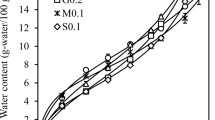Abstract
Sorption characteristics, thermo-mechanical and mechanical properties of bloodmeal-based thermoplastics have been investigated between water activities (a w) of 0.2 and 0.8, using water and tri-ethylene glycol (TEG) as plasticizers. Three different mass ratios of TEG to water were used, 1:1, 1:2 and 5:6 with a total plasticizer content of 60 parts per hundred parts bloodmeal. It was found that the equilibrium moisture content and mechanical properties were highly dependent on relative humidity suggesting that material properties may vary during use. The BET and Flory–Huggins equations gave the best fit for desorption and adsorption, respectively, but a significant difference was observed between adsorption and desorption behaviour below a water activity of 0.6, which was thought to be due to changes in intermolecular interactions. The monolayer adsorption capacity (0.05 g/g) was unaffected by the TEG content, using the BET sorption isotherm. The water activity required to form a monolayer (a wl) was also independent of the amount of TEG, but was different for adsorption and desorption (about 0.5 and 0.2, respectively). Increasing TEG did not have a strong influence on the equilibrium moisture content, especially at low water activity. Dynamic mechanical analysis revealed that the glass transition temperature decreased almost linearly with increasing water activity, ranging between 3 and 85 °C, however, above a water activity of 0.6 a second transition was observed, most likely due to phase separation. Depending of TEG content, tensile strength increased from about 10 to 15 MPa at a water activity of 0.4, where after a drastic decrease was observed. A similar trend was observed for elongation at break. At low water activity (below 0.4) elongation was less than 3%, increasing between 30 and 50% at higher water activities. It was concluded that 10–15 wt% represented a critical point above which mechanical properties becomes very sensitive to the relative humidity of the environment.






Similar content being viewed by others
References
Verbeek CJR, van den Berg LE (2009) Macromol Mater Eng 295(1):10
Verbeek C, van den Berg LE (2011) J Polym Environ 19:1. doi:10.1007/s10924-010-0232-x
Verbeek CJR, Viljoen C, Pickering KL, van den Berg LE (2009) NZ Patent NZ551531
Vanin FM, Sobral PJA, Menegalli FC, Carvalho RA, Habitante AMQB (2005) Food Hydrocolloid 19(5):899
Zhang Y, Han J (2008) J Food Sci 73(7):E313. doi:10.1111/j.1750-3841.2008.00867.x
Su J-F, Huang Z, Zhao Y-H, Yuan X-Y, Wang X-Y, Li M (2009) Ind Crops Prod 31(2):266
Hernandez-Izquierdo VM, Krochta JM (2008) J Food Sci 73(2):30
Maria Martelli S, Moore G, Silva Paes S, Gandolfo C, Laurindo JB (2006) Lebensm Wiss Technol 39(3):292
Cho SY, Rhee C (2002) Lebensm Wiss Technol 35(2):151
Verbeek CJR, van den Berg LE (2009) Recent Pat Mater Sci 2(3):171
Sharma S, Hodges JN, Luzinov I (2008) J Appl Polym Sci 110(1):459. doi:10.1002/app.28601
Swain SN, Rao KK, Nayak PL (2004) J Appl Polym Sci 93(6):2590
Zhang J, Mungara P, Jane J (2001) Polymer 42(6):2569
Pommet M, Redl A, Guilbert S, Morel M-H (2005) J Cereal Sci 42(1):81
Ortiz MER, San Martin-Martinez E, Padilla LPM (2008) Starch-Starke 60(10):577. doi:10.1002/star.200800212
Hochstetter A, Talja RA, Helén HJ, Hyvönen L, Jouppila K (2006) Lebensm Wiss Technol 39(8):893
Kristo E, Biliaderis CG (2006) Food Hydrocolloid 20(7):1057
Mali S, Sakanaka LS, Yamashita F, Grossmann MVE (2005) Carbohydr Polym 60(3):283
Perdomo J, Cova A, Sandoval AJ, García L, Laredo E, Müller AJ (2009) Carbohydr Polym 76(2):305
Fabra MJ, Talens P, Chiralt A (2009) Food Hydrocolloid 24(4):384
Cassini AS, Marczak LDF, Noreña CPZ (2006) J Food Eng 77(1):194
Brett B, Figueroa M, Sandoval A, Barreiro J, Müller A (2009) Food Biophys 4(3):151. doi:10.1007/s11483-009-9112-0
Jangchud A, Chinnan MS (1999) Lebensm Wiss Technol 32(2):89
Srinivasa PC, Ramesh MN, Kumar KR, Tharanathan RN (2003) Carbohydr Polym 53(4):431
Alix S, Philippe E, Bessadok A, Lebrun L, Morvan C, Marais S (2009) Bioresour Technol 100(20):4742
Sopade PA, Ajisegiri ESA, Chukwu O, Abass AB (2010) J Food Process Eng 33:385
Al-Muhtaseb AH, McMinn WAM, Magee TRA (2002) Food Bioprod Process 80(2):118
Kim SD, Chakravarti S, Tian J, Bell P (2010) Polymer 51(10):2199
Jonquières A, Perrin L, Arnold S, Lochon P (1998) J Membr Sci 150(1):125
Mo XQ, Sun XZ (2001) J Am Oil Chem Soc 78(8):867
Acknowledgements
The authors would like to thank Wallace Corporation for their support in supplying bloodmeal.
Author information
Authors and Affiliations
Corresponding author
Rights and permissions
About this article
Cite this article
Verbeek, C.J.R., Koppel, N.J. Moisture sorption and plasticization of bloodmeal-based thermoplastics. J Mater Sci 47, 1187–1195 (2012). https://doi.org/10.1007/s10853-011-5770-7
Received:
Accepted:
Published:
Issue Date:
DOI: https://doi.org/10.1007/s10853-011-5770-7




